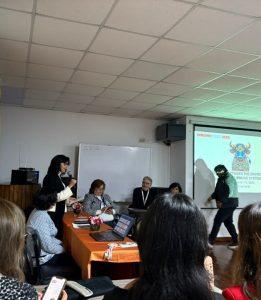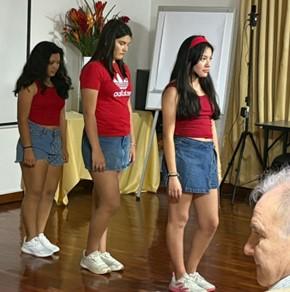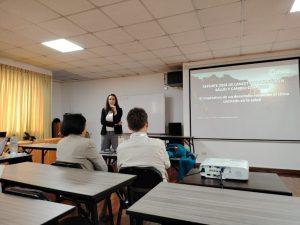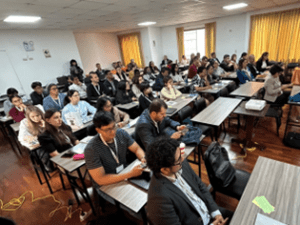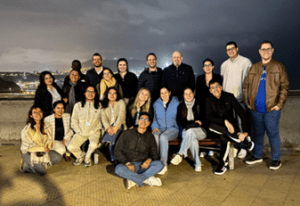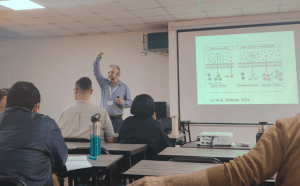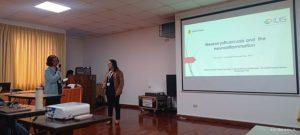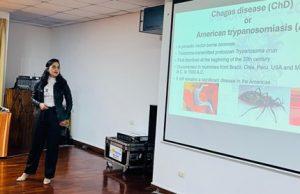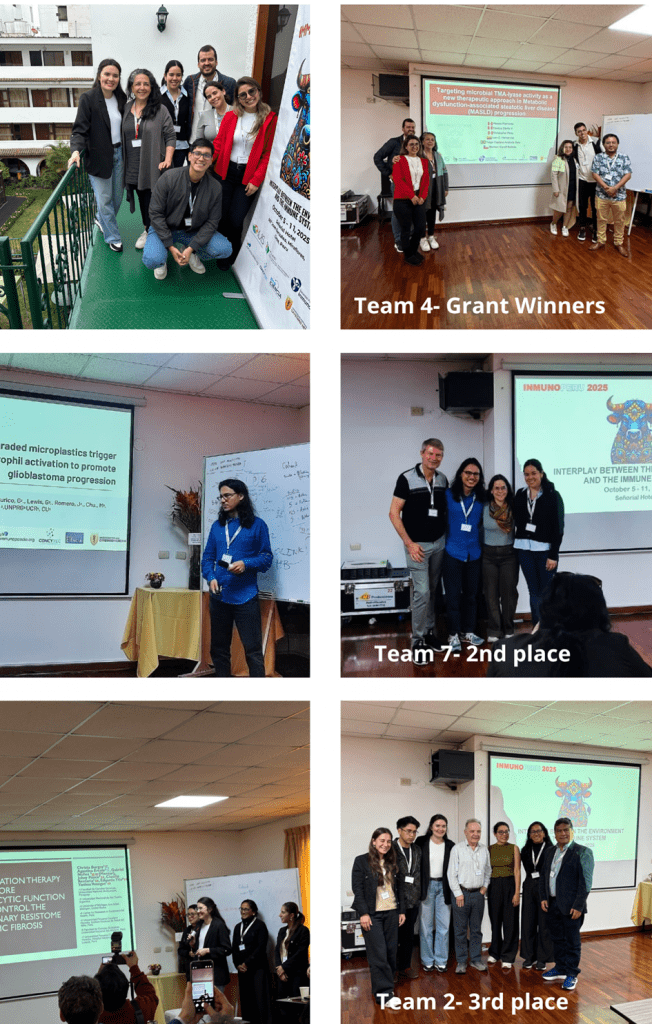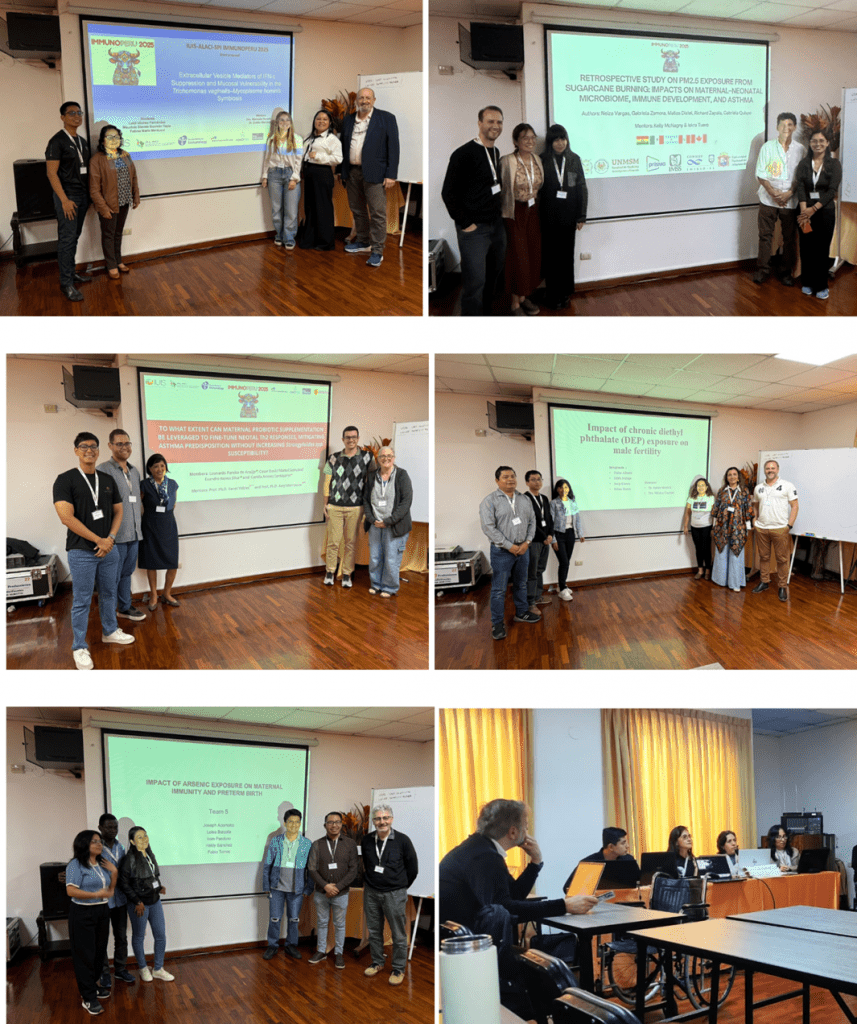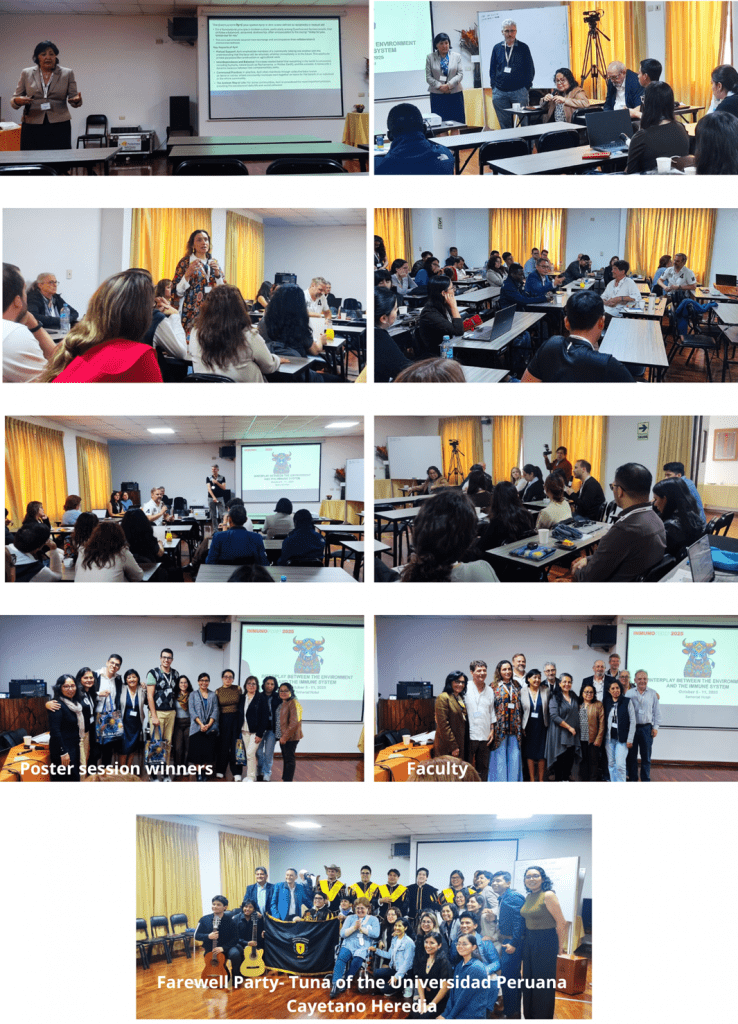A report by Immuno-Peru 2025 participants – including a daily summary, personal reflections and quotes from Faculty and other attendees.
Immuno-Peru 2025: Science, Culture, and Community in an Unforgettable Opening Night – Luisa Barzola
On the evening of October 5th, the main hall “Llaqta” filled with music, laughter, and science. That’s how ImmunoPeru 2025 began – an event that, more than a course, felt like a gathering of curious minds and hearts passionate about immunology.
The opening ceremony started with words from the organizing committee, who shared a message filled with gratitude and hope. They spoke about the value of science as a bridge that connects countries, disciplines, and generations, and the importance of building knowledge through collaboration and empathy. It was a warm and purposeful beginning, where every word reminded us that behind every discovery are people who believe in a better world through knowledge.
After that institutional welcome, the evening took a joyful and spontaneous turn. The university Tuna appeared among the audience with guitars, mandolins, and vibrant voices, filling the Llaqta with rhythm and smiles. Within minutes, applause and laughter blended with the music, and human moments that broke all formality and reminded us that science can also be celebrated.
The evening continued with dance performances that combined traditional and modern styles. The rhythm and colours of the dancers perfectly symbolized what ImmunoPeru represents: a fusion of cultural roots and scientific innovation.
Seeing that blend on stage was like witnessing the essence of who we are – tradition, diversity, and future.
Dinner became another moment of connection. Tables were filled with conversations about projects, dreams, and scientific curiosities. Amid laughter and anecdotes, dessert – a classic turron –reminding us that small details also build community.
More than a course, a Scientific Family
At the end of the night, I realised that ImmunoPeru 2025 was much more than an academic event. It was a network of people who believe in science as a tool for change, but also as a deep human space. As one of the professors said during the opening:
“ImmunoPeru is more than a course; it’s a family that keeps growing.”
And I couldn’t agree more. In just a few hours, I felt I had learned as much outside the classroom as inside. I left with a full heart – and yes, maybe too much turron, thinking about all that was yet to come in the days ahead.
Thanks to ProCiencia, IUIS, and ALACI for making this experience possible – one that unites, inspires, and remind us why we chose this path.
ImmunoPeru 2025 began with dancing, and I hope it continues that way – with joy, with passion, and with the certainty that science can also be felt.
Immuno-Peru 2025: Day 1 Summary – Marysol Chu Carty
The first day of ImmunoPeru set the tone for the entire course as we discussed justice, equity, diversity, and inclusion (JEDI). Dr. Guzman and Dr. Valdez led a session titled “Beyond Borders: Championing Respect and Inclusion in Immunology Research.” The session established the standard for the course; that as a community, we are committed to fostering a safe, respectful, and inclusive environment for everyone. It was an invitation for us to reflect and recognise that JEDI principles are not just good values for everyone to have, but that they are essential for conducting rigorous, impactful science, which is what we all aspire to do. One key moment from this talk was an illustration about how we go from reality to justice. In this four-panel image, we see a reality where unequal resource distribution creates disparity. When things become equal, we treat everyone the same, but that’s still not fair. Providing people with just what they need for support leads to equity; however, justice isn’t achieved until systemic barriers are removed and everyone can participate fully without requiring extra support. It captured the message from today that inclusion and justice in science require more than equal opportunities; they require systemic change and intentional equity. Additionally, we were reminded that “The way we choose to behave can build bridges or create barriers! Inclusion is a powerful tool for creating a world where everyone feels they truly belong.” I think it’s safe to say that we all walked away with a call to action: to practice self-awareness, recognise our own biases, and have the courage to call out unfairness. Building an inclusive scientific community takes all of us.
Dr Stella spoke to us about a crucial topic: climate change and its impact on health. In her talk, she showed how climate change affects cardiac diseases, mental health, asthma, and allergic conditions, and how vector-borne diseases such as malaria and dengue are increasing due to vector migration. Her reflections highlighted that Latin America is particularly relevant due to its unique territorial characteristics—for example, populations living in higher areas can release polluted waste, deforestation and pesticide use in the Amazon region contribute to carbon footprints. Many cities lack effective waste management systems. She emphasised the need to establish collaborative groups since there are few publications on pollution and health management implementations. In South America, various groups are currently collaborating.
After a reflective opening, we transitioned into our first scientific session with Dr Clive Gray giving a talk titled “Climate change and your health: the immune connection”. Dr Gray began with a quote from Samuel Taylor Coleridge: “The history of man for the nine months preceding his birth would, probably, be far more interesting and contains events of greater moment than all the three-score and ten years that follow it.” His talk centred on the idea that foetal-maternal tolerance is an immune balancing act. When maternal immune health is good, there is an immune balance in the placenta, resulting in a healthy newborn. But poor maternal immune health can lead to preterm birth and low birth weight. Dr Gray then linked this concept to climate change and the increase in temperature. Increased heat and infections can result in poor placental development with inflammation, vasculature abnormalities, breakdown of foetal-maternal tolerance and placental insufficiency. This results in poor immune ontogeny in the newborn, including inflammation, impaired B, T, and NK cell responses to vaccines, an altered microbiome, metabolic defects, and stunted growth. Ultimately, his talk emphasised that environmental stressors directly influence pregnancy outcomes, reinforcing the idea that the well-being of our environment and planet is essential to protect maternal and child health.
The next talk, given by Dr Monica Guzman, focused on how environmental exposures shape haematopoiesis and influence immune function. She began with a review of haematopoiesis, the process by which blood cells are formed. This process depends on hematopoietic stem cells (HSCs), which self-renew and differentiate into all blood lineages. However, clonal haematopoiesis (CH) can occur when these HSCs acquire somatic mutations, allowing certain mutant clones to expand disproportionately. Additionally, CH has been associated with an increased risk of hematologic malignancies, cardiovascular disease, and even higher mortality from non-hematologic cancers. Dr Guzman further explained that the environment and lifestyles can drive CH and presented three case studies showing how exposures such as spaceflight, radiation, and smoking contribute to this process. One example involved twin astronauts whose blood samples revealed CH with distinct mutational profiles, and interestingly, these mutations appeared almost two decades earlier than the age when CH is typically detected. She also discussed findings from World Trade Center (WTC) first responders, who were exposed to toxic gases and carcinogens during the 9/11 attacks. Sequencing blood samples showed that a significantly higher proportion of WTC-exposed first responders had CH compared to non-WTC firefighters. Finally, she described a long-term cohort study from the Women’s Health Initiative, which followed 212 women who later developed acute myeloid leukaemia (AML). Those who eventually developed AML had more mutations at baseline than controls, suggesting that CH may serve as an early predictor of disease development. Overall, the talk highlighted that the environmental impact could leave a lasting mark on our hematopoietic system, which can have consequences decades down the road.
The afternoon featured a panel discussion on emerging technologies for evaluating immune diseases. One of the platforms discussed was Olink, which is a proteomics technology that measures protein expression using a Proximity Extension Assay (PEA). This approach allows for highly sensitive detection and quantification of specific proteins, including cytokines, chemokines, and immune mediators. We then learned about FRET (Förster Resonance Energy Transfer), a technique used to study protein interactions and signalling complexes within cells or tissues. FRET can help identify which pathways are activated, how immune cells communicate, and how potential therapies might disrupt these interactions. The final technology discussed was spectral flow cytometry. Unlike conventional flow cytometry, which can measure only about 10–15 markers at once, spectral flow cytometry can detect up to 30 or more markers, allowing for a more complex analysis panel. It also uses artificial intelligence to correct spectral overlaps, removing the need for manual compensation. These technologies are a huge advancement and invaluable tools for scientists. However, even with all these powerful methods, the key message we were reminded of is that the most important part of doing science is not the technology itself but rather thinking about the question we want to answer.
This was a great way to prepare us for our first in-person meeting with our grant proposal teams. We spent the evening brainstorming our research questions, discussing why they matter, and determining the best approach. It felt like the perfect transition from learning about the cutting-edge tools available to us to thinking about how to use them intentionally for our proposals.
Overall, the first day was an impactful and inspiring start to what was sure to be a week filled with collaboration, discussion, and discovery. It set the tone for a course that not only deepened our understanding of immunology but also reminded us of the shared responsibility we have: to conduct science that is inclusive, thoughtful, and driven by meaningful questions.
Voices from Immuno-Peru:
Monday’s session was incredibly enriching. We explored the importance of equity, equality, diversity, and justice, and we identified with the help of Dr Monica and Dr Janet some examples of microaggressions that can occur within academia, and learned about tools to combat them, including the importance of an Ally, as Dr Kelly showed us.
We also discussed the significant impact of the environment on people’s health, particularly in Latin America, and the need to join forces to counteract the damage in the region.
We learned firsthand about cutting-edge technology that can be applied to answer research questions, but how these questions are formulated is also crucial. Finally, we had the opportunity to work with our teammates in person for the first time, which was a very rewarding experience.
— Gabriela Zamora
Immuno-Peru 2025: Day 2 Summary – Marysol Chu Carty & Dulce Alberto
Day 2 of the Immuno-Peru course centred on three main themes: environmental exposures in allergic and metabolic diseases, microbiome and autoinflammatory disorders, and environmental factors in cancer and leukaemias. Throughout the day, speakers highlighted how advances in immunology and molecular biology are helping us understand the relationships between our genes, the environment, and our immune system.
The morning began with Dr Gabriel Núñez, whose work focuses on the gut microbiome and Crohn’s disease. He explained that while individuals share many microbial species, each person’s microbiota composition is unique. This diversity begins from infancy, where breastfeeding promotes the growth of oxygen-tolerant bacteria, while weaning and the introduction of solid foods support the rise of anaerobes that thrive on complex sugars and fibres. Dr Núñez’s central question was whether Crohn’s disease arises from a general microbiome imbalance, known as dysbiosis, or from the overgrowth of specific bacterial species, known as pathobionts. His group discovered that mice lacking two Crohn’s disease-associated genes, NOD2 and CYBB, spontaneously develop colitis that closely resembles human Crohn’s disease. They found that a single bacterium, Mucispirillum schaedleri, was responsible for triggering the inflammation in these genetically susceptible mice. This work demonstrated that genetic mutations can disrupt the immune system’s ability to regulate specific microbes, turning once-harmless bacteria into drivers of disease.
Later in the day, Dr César Galván presented compelling research on the global rise of allergic respiratory diseases such as asthma and rhinitis, which now affect nearly one-third of the population. He states that Peru has one of the highest rates of allergy and asthma worldwide, making it an ideal location to study environmental influences. To my surprise, Peru contains 38 distinct climate types across its 24 regions, so his team focused on how climate, altitude, and humidity shape allergic sensitisation across different areas. Comparing data from Lima, Arequipa, Piura, and Tarapoto, the study found that regional climate differences within Peru have a significant influence on the prevalence and severity of allergic diseases. Even cities sharing similar overall climate classifications showed distinct allergy patterns, revealing how microenvironmental conditions can influence immune responses.
The next presentation shifted its focus to environmental exposures and reproductive health, emphasising the rapid decrease in global fertility rates and sperm quality over recent decades. Dr Reuben Motrich highlighted that infertility is not just a women’s health issue, but that 50% of infertility cases were linked to men, with growing evidence linking environmental toxins to reduced sperm motility and increased oxidative stress. Studies in Argentina showed that men exposed to glyphosate, a widely used herbicide, had higher inflammatory markers and poorer semen quality. Additionally, in mouse models, glyphosate exposure in the male mice affected placental development and foetal growth. The discussion presented evidence that the impact of these environmental pollutants may extend across generations, highlighting a need for greater awareness and research in the field.
The afternoon sessions shifted their focus toward cancer biology and therapeutic innovation. Dr Mónica Guzmán spoke about leukaemia stem cells and targeted therapies in acute myeloid leukaemia (AML). She reminded us how early studies by John Dick established the existence of leukaemia stem cells, therapy-resistant cells that drive relapse. She shared her lab’s ongoing efforts to target AML more effectively. Dr Guzmán discussed multiple strategies, including CAR-T cells targeting the CD123 surface marker and inhibition of the epichaperome, a network of proteins centred on Hsp90 that cancer cells rely on for survival. She included a moving story about a patient with an unclassified myeloproliferative neoplasm harbouring a novel PML-SYK fusion, who relapsed to AML despite an allogeneic stem cell transplant. Based on the poor prognosis, lack of effective or alternative therapies, and laboratory findings demonstrating high epichaperome levels that predicted an increased likelihood of response to PU-H71, the patient was granted a compassionate trial with this inhibitor. After only 45 days, the patient achieved a complete and durable remission that lasted nearly five years. This powerful example reminded all of us that discoveries at the bench can truly transform lives at the bedside.
Overall, Day 2 demonstrated that solving complex health problems requires both collaboration and curiosity across disciplines, cultures, and backgrounds. Bringing together diverse perspectives, united by a shared goal to advance science and improve human health, is what drives true innovation and impact.
Personal Reflection:
I was very excited to start Day 2, which was filled with talks both outside my area of study and closely connected to the work I’ve seen my colleagues pursue in Dr Guzmán’s lab. The variety of topics, from microbiota and environmental exposures to reproductive health and leukaemia, made it one of the most engaging and thought-provoking days of the course thus far.
Dr Núñez’s talk on how the microbiota begins shaping our biology from the moment we are born was particularly fascinating, as I had never realised how breastfeeding and early diet determine which bacteria colonise our intestines, or how, as we transition to solid foods, the microbiota shifts to favour anaerobic species that digest complex fibres. His work on Crohn’s disease highlighted how genetic susceptibility and microbial imbalance can intertwine to maintain or disrupt health.
I felt a deep sense of connection and curiosity when we began discussing the research on how Peru’s regional climates influence allergies and asthma. Learning more about its geography, climates, and diverse landscapes made me feel closer to home. It was both scientifically and personally meaningful to see Peru’s environmental diversity being used to advance global understanding of human health.
As we moved on through the day, the session on reproductive health and environmental toxicants was equally eye-opening. Learning that widely used herbicides like glyphosate can impair male fertility and even affect placental development across generations was something that I had not previously heard about or discussed. It opened my eyes to a whole new area of research that is equally as importanszt but perhaps less talked about. It emphasised the need for more research and regulation to protect reproductive health. This field traditionally focuses on women’s health and has overlooked how men’s health can also contribute to the problem.
Ending the day with Dr Guzmán’s lecture was especially meaningful. Hearing her describe the compassionate trial case of PU-H71, a project I’ve heard discussed in our lab, reminded us all why translational research matters. Seeing how discovery at the bench can directly transform a patient’s life, and watching faculty and students exchange questions and ideas, reinforced why gatherings like this are so valuable. They remind us that science is not only about experiments, but also about connection, purpose, and hope.
Voices from Immuno-Peru:
“The talks on October 7th were very interesting, diverse, and broad. I was especially impressed in learning about different types of work, from basic research to observational studies. I learned a lot about microbiota (intestinal and vaginal), leukaemia, and how sociodemographic variables have an important relationship with the risk of developing leukaemia. I also learned how exposure to pesticides can impact male infertility.
— Aida Elizondo
I found it striking that these talks made visible how environmental exposure and climate change are negatively and silently impacting different aspects of our health. This made me reflect deeply on the importance of making this more visible, but also of seeking possible solutions.”
“Today’s session was highly important for me, providing essential insights into the interaction between the microbiota and the immune system. The topics covered allowed for the consolidation and expansion of prior knowledge, delving into particularly relevant aspects such as the modulation of the microbiome by stress and the critical role of the microbiota in various experimental models. This experience significantly contributes to a more comprehensive and nuanced understanding of the microbiota–immunity axis.”
— Matias Distel
Immuno-Peru 2025: Day 3 Summary – Dulce Alberto
Dr Manuela Verástegui discusses “Neurocysticercosis and Neuroinflammation.” Analyses of patient samples revealed spheroids containing neurocysticerci and neurons; similar spheroids were also found in neurocysticercosis of rats and pigs. The functions and characteristics of these structures remain under study.
April 14th is Chagas Disease Day, and with Dr Olivia Rodríguez, we learned that Mexico is among the most affected countries. In chronic symptomatic disease, Mexican patients are mainly affected by the cardiac form, while in South America, gastrointestinal disease is most common. This is due to various reasons, including variability in trypanosome strains, genetics, and, of course, immunological variability and environmental factors. Treatments exist, but adverse effects are common, highlighting the importance of research in this field. Dr Mónica Pajuelo discussed congenital Chagas disease and identified differentially expressed microRNAs in the maternal placenta. Many microRNAs are differentially expressed, offering potential therapeutic targets and diagnostic biomarkers.
Dr Emilio Malchiodi impressed with his knowledge of current vaccine platforms and their importance. For example, the yellow fever vaccine is produced in chicken eggs—effective but not universally feasible. Many vector-borne diseases have vaccines (dengue, chikungunya); however, most parasitic diseases lack vaccines due to their complex humoral and cellular immunology. Although parasitic vaccines have been developed and tested in non-human primates (NHPs), human responses often differ. One example is Cruzivax, an antibody vaccine with cAMP as an adjuvant, created by an Argentinian group headed by Dr Malchiodi and tested in NHPs; unfortunately, it had a high mortality in the animal model.
Dr Iskra Tuero show us the “Breaking paradigms in tuberculosis: can antibodies change the course of the disease”. Her research teaches us that there is a differentially expressed glycosylation profile in those Fc fragments of antibodies present in a Tb active compared with that latent, and the evidence suggests a change in those antibodies found at the beginning of the disease compared with those at the other disease stage. This opens the opportunity to develop new diagnostic tests based on the immunoglobulin profile. Primarily, antibodies can be used as a complementary treatment.
Dr Maria Quispe Ricaldi told us about the humoral immune response in leishmaniasis disease. There, she shared with us about how difficult the diagnosis of this disease is, and how the protein profile can be differentially expressed in the disease. Some of those molecules have been tested, showing good sensitivity, but the specificity is under review because some of the diagnoses can be confounded with Trypanosoma.
Personal reflection:
For me, it was surprising to learn about the development process of the yellow fever vaccine, because of its traditional method but with limited scalability and traceability. Yet its effectiveness remains very high.
Also, it was fascinating how researchers are focusing on developing therapeutic opportunities for this kind of disease. In particular, the work of Doctors Manuela Verástegui and Monica Pajuelo is wonderful; I think both have opened a box of many opportunities and scientific diamonds to discover.
The museum visit was wonderful. We learned about the Caral civilisation, a pre-Inca civilisation among the oldest in the Americas. It’s enriching to learn about their culture and traditions, as their knowledge continues to influence us today.
In general, I consider that this course has given me more than knowledge. It breaks down barriers for all participants. Immuno-Peru had connected immunology to an urgent area of focus: environmental immunology. Collaborating, we can establish a world prioritising disease prevention over damage control.
I really hope all attendees are in touch to help us rescue all the pearls we have put on the table and participate in the writing of the position paper and collaborations.
Short reflections from Faculty:
“Immuno-Peru was a completely new group of investigators and research questions for me, which resulted in both a challenging and rewarding experience. I felt a strong bond with my grant writing group and enjoyed meeting faculty from a completely different area of science from me.”
— Dr Amy Morrison
I was very pleased with the response from the students about my very field-oriented talks, I felt like all were so open to the message that in science we need to collaborate as scientists and get to know the communities we are asking for samples.”
— Dr Amy Morrison
“A shout out to my bus buddies on our trip to the Ministry of Culture and Museum, Sr. Emilio, I’d be happy to spend another day together on the bus”
— Dr Amy Morrison
Voices from Immuno-Peru:
“Hello, my name is Thiago, and I am from Alfenas, a city in the state of Minas Gerais, Brazil. Being in Peru was, without a doubt, one of the most remarkable experiences of my life, especially because it allowed me to immerse myself in a different culture, language, and set of customs. Meeting people from other countries and such renowned professors was a great honour. I felt truly happy, as a few years ago, the idea of experiencing something like this would have seemed utopian to me.
The Peruvian culture fascinated me, especially its gastronomy and history. Moreover, the climate and demographic characteristics are quite different from those in Brazil, which made everything even more interesting. What surprised me the most was realising how advanced and technologically developed the ancient civilisations of the region were. We often assume that only the Europeans or the Greek and Egyptian civilisations were the most sophisticated, but that is completely wrong — the Latin American peoples were just as advanced.
ImmunoPeru taught me a lot, not only in terms of immunology but also by allowing me to explore new research fields and build wonderful professional connections. And, wow, being awarded for my poster presentation was simply incredible! That work took years to develop; my PhD research was represented on that banner, and seeing it recognised made my heart celebrate and dance. Furthermore, our group winning first place in the project competition was amazing!
I am deeply grateful for this course. Never in my life would I have imagined that, coming from the interior of Brazil, I would be able to take part in such an event, gain so much knowledge, and still be recognised with these awards.”
— Thiago Belo
“Winning the grant proposal in ImmunoPeru was an incredibly valuable experience. This achievement reflects not only individual effort but, above all, teamwork. We learned that a multidisciplinary approach, with each member bringing a different expertise, could contribute a crucial part to the development of our proposal. A key role was played by our mentor, Dr Caroll Beltrán, who knew how to guide us, push us, and help us develop a strong research question. From that, we precisely defined what we were going to do and how to do it. From start to finish—preparing the grant to the final presentation—we operated as a true team. That was what I liked most. We rehearsed our presentation, refined during practice what to keep or remove, and adjusted our timing to eight minutes. One of the strategies that contributed to this achievement was our collective collaboration: everyone helped, every contribution was valuable, and each person brought a unique skill or information to the project at some point. It was very satisfying to win first place in the grant proposals.”
— Danitza Davila
Immuno-Peru 2025: Day 4 Summary – Gabriela Zamora Herrera
Infectious diseases
Thursday’s session explored how climate change and environmental factors influence the emergence and spread of infectious diseases.
Dr Iris Goyzueta presented transmission cycles of several infectious diseases that significantly affect Latin America, particularly Peru. She highlighted environmental parameters, including parasite egg survival, mosquito density and feeding frequency, as well as larval habitats. In the case of mosquito vectors, factors like feeding frequency, the gonotrophic cycle, and extrinsic incubation periods were discussed.
Dr Cesar Ramal spoke about the creation of a research facility focused on metaxenic diseases—those transmitted from animals to humans via a vector. These diseases are strongly influenced by climate change.
Dr Amy Morrison delivered two outstanding talks. In the first, she emphasised the importance of collaborative networks in disease research, using her team’s work on the Chikungunya virus as an example. Their One Health approach investigates not only human disease but also mosquito populations, which they monitor using cost-effective and efficient devices developed by her group. They also conduct epidemiological surveillance in primates, using minimally invasive saliva collection devices that operate while the animals eat. In her second talk, she underscored the importance of fostering social engagement within communities—not only to collect samples but also to promote a culture of prevention through education.
Dr Christian Campos explained that the immune response to dengue is a double-edged sword: while it helps control infection, the inflammatory process can intensify and contribute to clinical severity. To assess disease severity, cytokine profiling is useful, as it involves examining pro-inflammatory markers such as IFN-γ and TNF-α, as well as regulatory markers like IL-10 and TGF-β. The climatic influence becomes even more pronounced when considering the population’s immunological landscape (susceptibility levels and exposure history), which better explains the observed epidemic waves.
Dr Carlos Vera shared that the life expectancy for women in Peru is 78.1 years, and that inflammation is associated with immunosenescence—the gradual deterioration of the immune system due to ageing.
Finally, Dr Pilar Sugimoto walked us through the development process of a freeze-dried LAMP diagnostic kit for malaria.
The day concluded with final team meetings focused on drafting the grant proposal.
Personal Reflection:
Personally, I found it remarkable to see how infection transmission is clearly affected by climate shifts—and even more so, how the patient’s surrounding environment can compromise the immune response itself.
Immuno-Peru 2025: Day 5 Summary – Christa Burgos
The morning sessions were dedicated to presenting the grant proposals developed by each team during the week. These presentations showcased the creativity, rigour, and interdisciplinary spirit that defined the course. The winning project, “Targeting microbial TMA-lyase activity as a new therapeutic approach in metabolic dysfunction-associated steatotic liver disease (MASLD) progression”, by Team 4 under the mentorship of Dr Caroll Beltrán, stood out for its innovation and strong translational potential. Team 7 earned second place with their project on “Degraded microplastics trigger neutrophil activation to promote glioblastoma progression” (mentor Dr Michael Schnoor), and Team 2 took third place with “Combination therapy to restore phagocytic function and control the pulmonary resistome in cystic fibrosis” (mentor Dr Gabriel Núñez).
The poster session awards recognised excellence in research presentation. In the clinical category, Claudia Rentería was awarded for her work “Pediatric STAT3 Hyper-IgE Syndrome: A case series.” In the fundamental category, the prize was shared among Aída Elizondo, Leonardo Pereira de Araújo, and Thiago Andrade Belo, whose projects reflected the diversity and depth of research across Latin America.
The day’s roundtable, “How can we move forward as Latin Americans in Immunology?”, opened space for reflection and collective vision. Participants emphasised the importance of promoting inclusion, overcoming language barriers, and creating safe and open environments for exchanging ideas. Discussions led to concrete agreements. The concept of Immuno Ayni, reciprocity and shared growth, emerged as a guiding principle for future collaborations.
As evening arrived, the farewell dinner gathered participants and faculty in a friendly atmosphere. The evening was accompanied by the Tuna of the Universidad Peruana Cayetano Heredia, whose performance added a touch of cultural tradition to the closing ceremony. The program concluded with a shared commitment to maintaining the professional and scientific networks established during ImmunoPeru 2025.
Personal reflection:
For me, ImmunoPeru was a profound reminder of why we do science: to connect, to learn, and to build something greater together. Witnessing so many talented, passionate minds from across the continent reaffirmed my belief that collaboration is our strongest tool. Every lecture, discussion, and group activity reinforced the importance of creating spaces where ideas can be shared openly and respectfully. What we created this week is not ending; it’s only the beginning of our Immuno Ayni.
Immuno-Peru reminded me why we do science: not only to discover, but to connect, to generate knowledge that transcends borders and transforms lives.
Voices from Immuno-Peru:
“Winning the grant in the Immuno-Peru 2025 course was a truly enriching experience for me. Beyond the recognition itself, what I value most is having witnessed how interdisciplinary teamwork can enhance ideas.”
— Danitza Dávila, Grant Winner, Team 4
“It was an incredible experience, rich in knowledge, understanding and memorable moments. I met inspiring people with kind hearts and a deep passion for science.”
— Alessia Piamonte, Team 4
“Being in Peru was one of the most remarkable experiences of my life. Meeting people from other countries and such distinguished professors was a true honour. ImmunoPeru broadened my knowledge and filled me with joy and gratitude.”
— Thiago Andrade Belo, Team 4, Grant & Poster Winner
“I am deeply grateful for this opportunity to learn and share with such an exceptional group of people, both mentors and friends. This recognition reinforces the importance of applying immunology in clinical practice. My special thanks to my colleagues for making this an unforgettable experience, marked by a strong sense of belonging.”
— Claudia Rentería, Poster Winner, Clinical Category
Edited by Bonamy (Bon) Holtak – Immunopaedia Foundation NPC






